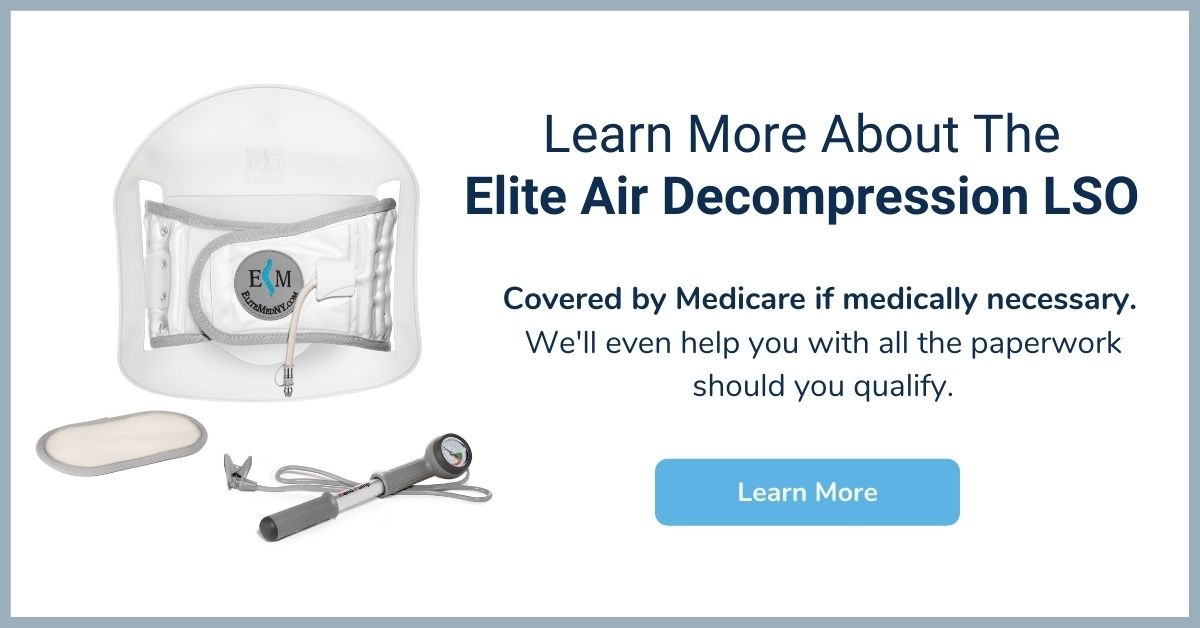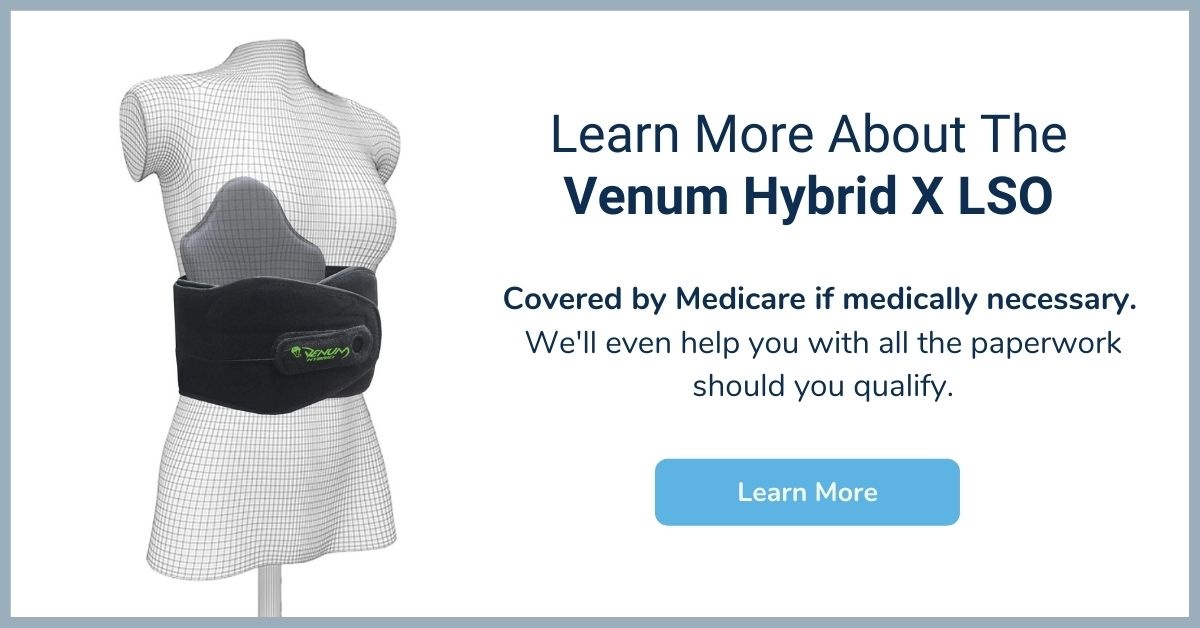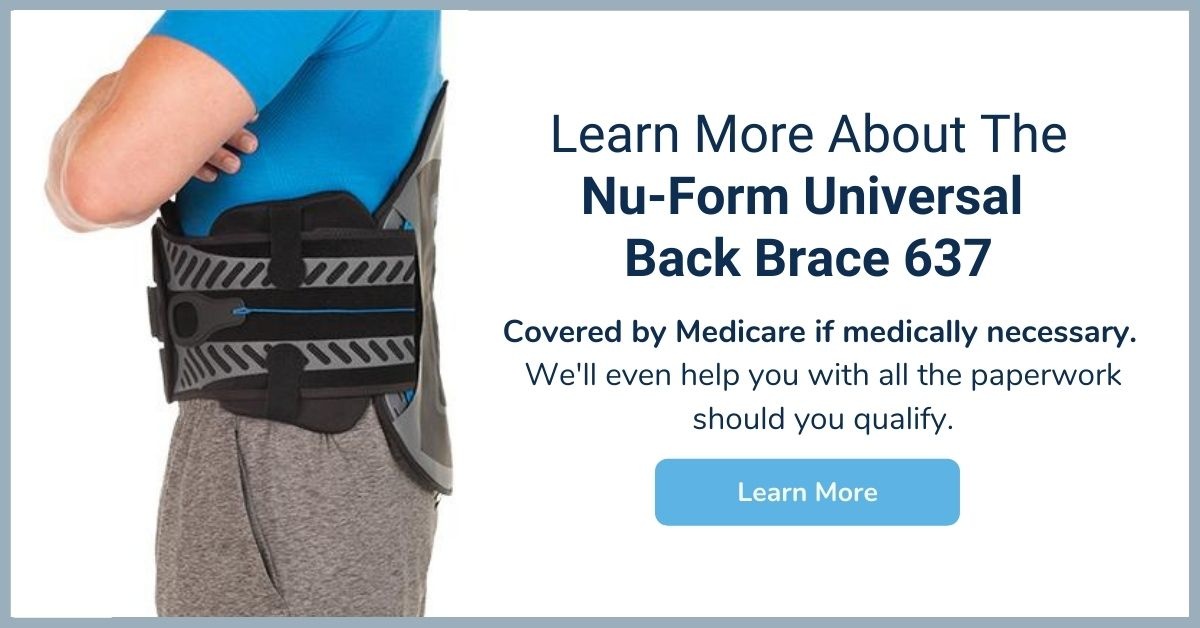How to Find the Right Back Brace to Manage Degenerative Disc Disease
Over the course of a lifetime, our bodies experience a natural amount of wear and tear. Conditions manifest at different times and in a variety of ways depending on factors from genetics to jobs to lifestyle choices. One such condition is Degenerative Disc Disease (DDD). Learning how to spot the symptoms and support your back with a high-quality brace is an important step in dealing with DDD.
What Is Degenerative Disc Disease?
Degenerative Disc Disease is the natural result of wear and tear on your spinal discs. It is one of the most common causes of neck and lower back pain.
Painful disc degeneration is common in the neck (cervical spine) and lower back (lumbar spine). These areas of the spine undergo the most motion, physical stress, and are most susceptible to disc degeneration. (Spine-Health)
Symptoms of DDD may include the following:
- Chronic, low-level pain in the back or neck
- Intermittent bouts of severe pain in the back or neck
- Weakness and numbness in the arms or legs
- Shooting pains down the arms or legs
Contact your doctor to discuss if you are dealing with these symptoms. The sooner your condition is confirmed, the sooner you can seek support and treatment.
How Does a Back Brace Help?
In the case of DDD, a back brace is often recommended.
When a spinal disc begins to break down or herniate, a rigid or semi-rigid back brace can help stabilize and reduce micro-motions at the affected spinal segment. With the correct back brace, you'll be able to go about your daily life enjoying increased support and stability while experiencing less pain from your condition.
A back brace may also be used to limit bending and twisting motions that can increase damage from DDD. This is especially important if your daily activities require a significant amount of movement.
Finding the Right Back Brace
Of course, finding the correct back brace is key. You want to concentrate on finding a brace that best suits your needs.
The Elite Air Decompression LSO
The Elite Air Decompression LSO can be utilized with DDD that has some radicular symptoms into the leg. This brace offers decompression to reduce painful symptoms and also offers rigid panels that provide lumbar support.
Aspen OTS 650
The Aspen OTS 650 is a one-size, adjustable back brace that provides increased control for those who need rigid support. It helps stabilize the trunk and allows you to get back to moving around with confidence.
Venum Hybrid
The Venum Hybrid back brace reduces pain while providing support for the lumbar-sacral spine. As a bonus, it boasts a streamlined design and is made from a hypoallergenic material that wicks away perspiration.
Nu-Form Universal 637
Breathable and durable, the Nu-Form Universal 637 relieves pressure on the lower back while lending support and comfort.
Support That Requires Less Lumbar Restriction and Support
For those seeking lighter and more flexible lumbar support, there are other options available, such as the Aspen OTS Lumbar 642.
Aspen OTS Lumbar 642
The Aspen OTS Lumbar 642 is a low-profile brace that covers less of the lumbar region and offers rigid support. The perfect choice for less severe conditions or those dealing with early-onset cases of Degenerative Disc Disease, the Aspen OTS Lumbar 642 is great for those seeking non-narcotic, non-invasive treatments for low-level DDD.
Elite Medical Supply Can Help
Dealing with Degenerative Disc Disease is never easy. Fortunately, back braces from Elite Medical Supply can help.
For more information on our premium products, please feel free to contact us.
Written by Elite Medical Supply of NY
Braces and Products Covered by Medicare
Browse ProductsRecent Posts
- Spinal Decompression at Home: What It Is, How It Works, and Whether It’s Right for You
- Manage Osteoarthritis Progression With a Quality Knee Brace
- Product Highlight: Aspen Active™ P-TLSO
- Understanding Radiculopathy: Causes, Symptoms, & Treatment Options
- Alternatives to Back Surgery: What you Should Know
Topics
- Back Braces (39)
- Knee Braces (31)
- Medicare Beneficiaries (31)
- Pain (24)
- Non-Opioid (22)
- Medical Providers (19)
- Lower back pain (11)
- Product Highlight (11)
- Sciatica (11)
- Muscle Spasms (9)
- Decompression (8)
- Lumbago (8)
- Degenerative disc disease (6)
- Lumbar Spinal Stenosis (6)
- Spinal Stenosis (6)
- Working with your doctor (6)
- Fracture healing (5)
- Herniated Nucleus Pulposus (5)
- Bulging or herniated disc (4)
- Quadratus Lumborum Syndrome (4)
- SI Joint (4)
- SI Joint Dysfunction (4)
- Spondylolysis (4)
- Wrist Pain (4)
- Bone Growth Stimulator Therapy (3)
- Bone Growth Stimulators (3)
- Carpal Tunnel Syndrome (3)
- Neuromuscular Electrical Stimulation (NMES) (3)
- Unicompartmental Osteoarthritis (OA) (3)
- Wrist Brace (3)
- wrist tendinitis (3)
- Braces for Golf (2)
- Electrical Stimulation (2)
- Failed Spinal Fusion Syndrome (2)
- Kyphosis (2)
- Lumbar compression fractures (2)
- Radiculopathy (2)
- Spondylolisthesis (2)
- Supine Cervical Traction (2)
- Total Knee Replacement (2)
- Wrist Braces (2)
- Ambulatory Cervical Traction (1)
- Arthritis (1)
- Braces for skiing (1)
- Cervical Traction (1)
- De Quervain Syndrome (1)
- Digital DME Orders (1)
- Knee Brace Accessory (1)
- Knee Suspension Wrap (1)
- Knee brace support for skiing (1)
- Medicare Scam (1)
- Muscle Atrophy (1)
- PCL (1)
- Patellofemoral Pain Syndrome (1)
- TLSO (1)
- Ulnar Tendinitis (1)




